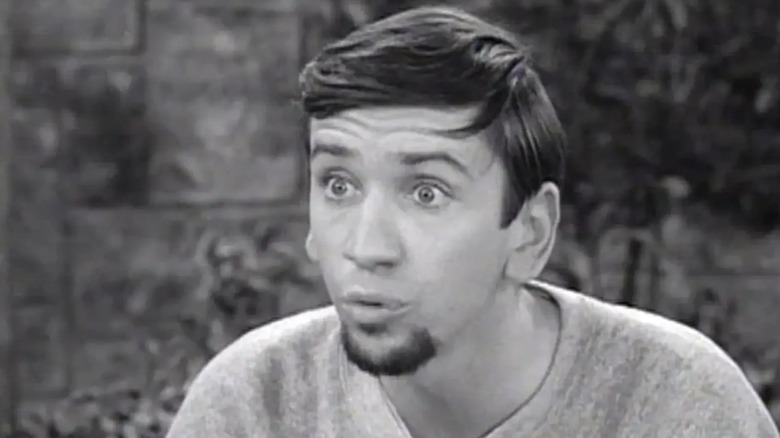A Gilligan's Island Star's Earlier Sitcom Led To The Creation Of Scooby Doo
Bob Denver was attending school at Loyola Marymount University in Southern California when he was bitten by the acting bug. He started appearing in college stage productions, finding he had a talent for a certain kind of broad character work. He would become friends with fellow actor and LMU student Dwayne Hickman, a friendship that would prove fortuitous. Six years after they graduated, Denver and Hickman would star as the co-leads of the 1959 sitcom "The Many Loves of Dobie Gillis." Hickman played Dobie Gillis, a well-meaning but kinda directionless teenager who always dreamed of dating models and/or sophisticated women. He was never successful in his goals, but he was charming in his constant attempts.
Denver, meanwhile, played Dobie's best friend, Maynard G. Krebs. Krebs is often cited as the first beatnik to ever appear on mainstream television. He spoke using a modern hipster's lexicon, loved jazz, and hated Lawrence Welk. Importantly, Krebs eschewed the very notion of work, often incredulously repeating the word when it was uttered in his presence. In 1959, Krebs was probably the coolest cat to appear in any pop sitcom. He was certainly an inspiration for Arthur "The Fonz" Fonzarelli on "Happy Days." Indeed, Maynard G. Krebs became an archetype imitated by multiple TV shows for a generation. "The Many Loves of Dobie Gillis" latest an impressive 147 episodes over its four seasons, making Bob Denver a big star. The year after "Dobie" went off the air, Denver landed the title role in Sherwood Schwartz's 1964 sitcom "Gilligan's Island," playing one of TV's most enduring characters. The rest is history.
But comedy fans never forgot Maynard G. Krebs, TV's original beatnik. Indeed, as elucidated by the Legends Revealed website, Maynard G. Krebs was the direct inspiration for Shaggy (Casey Kasem) on Hanna-Barbera's 1969 animated series "Scooby-Doo, Where Are You!"
Maynard G. Krebs was the direct inspiration for Shaddy on Scooby-Doo
Shaggy, of course, was the comedic layabout on "Scooby-Doo," the cowardly hippie who tooled around with fratboy Freddie (the amazing Frank Welker), golden girl Daphne (Stefanianna Christopherson, Heather North), and nerd champion Velma (Nicole Jaffe, Pat Stevens). Shaggy and Scooby (Don Messick) were best buddies, but both tended to run from danger. As Suzy Eddie Izzard once pointed out, Shaggy and Scooby — as characters — were Shakespearean levels of genius. They were cowards, but they were always upbeat and energetic. They were like Falstaff.
And one can see on the screen the similarities between Shaggy and Maynard G. Krebs. They both sported small goatees with no mustaches and shaggy hair. They were also both laidback in that beatnik sort of way. Neither "The Many Loves of Dobie Gillis" nor "Scooby-Doo, Where Are You!" made explicit references to marijuana, but fans of both shows have posited that both Maynard and Shaggy were deep into its consumption. Maynard was a beatnik, while Shaggy was tipping into 1960s hippie territory.
But the inspiration is actually more direct than mere visual similarities. According to the Legends Revealed website, the "Scooby-Doo" series was a request from Fred Silverman, the head of programming at CBS. He wanted an animated series that combined elements of the hit series "The Archie Show" — specifically, the teen rock band element — with Agatha Christie-like mysteries. Will Hanna and Joseph Barbera, working with Joe Ruby, Ken Spears, and Iwao Takamoto to make a very literal version of what Silverman asked for, coming back with "Mysteries Five," a series that featured analogs of the "Archie" characters, alongside a bongo-playing dog named Two-Much.
Silverman didn't like "Mysteries Five" and asked the five animators to try again. This time, though, he said he wanted the human characters to resemble the leads on "The Many Loves of Dobie Gillis." The connection was direct now.
The four leads on Scooby-Doo are the same characters as on Dobie Gillis
The four leads of "Dobie Gillis" were Dobie, Maynard, Thalia (Tuesday Weld), and Zelda (Shelia James). Thalia had a little more character than Daphne, in that Thalia was interested in status and class and would only periodically date Dobie if he had come into money. Zelda, however, was very much like Velma in that they were both the intellectuals of the group. Zelda, however, was not-so-secretly in love with Dobie. Meanwhile, Freddie was nothing like Dobie, emerging as a guileless hero. Maynard G. Krebs was the most direct translation, spawning Shaggy with ease. As for the talking dog, Scooby was a wholly original creation.
Once Silverman suggested that Hanna, Barbera, Ruby, Spears, and Takamoto model their show on "The Many Loves of Dobie Gillis," it came together quickly. Silverman loved the new re-working, which was originally called "Who's S-S-Scared?" Silverman brought the series to his bosses, and they suggested that the series be made more comedic and that the talking dog be made the central character. It was the top brass at CBS who suggested the dog be named "Scooby-Doo" after the chorus of Frank Sinatra's hit song "Strangers in the Night."
In a strange twist of fate, "Scooby-Doo, Where Are You!" became a runaway success, surpassing even "The Many Loves of Dobie Gillis" in popularity. These days, Bob Denver is better known for his work on "Gilligan's Island," and Shaggy has supplanted Maynard G. Krebs as TV's premiere beatnik/hippie. Scooby movies are being made to this day, and Frank Welker is still playing Freddie (he also took over playing Scooby when Don Messick died). There are dozens of movies, just as many TV spinoffs, and a planned live-action series. "Dobie Gillis" was left in the dust in terms of popularity, but Scooby fans owe it a cultural debt of gratitude.


